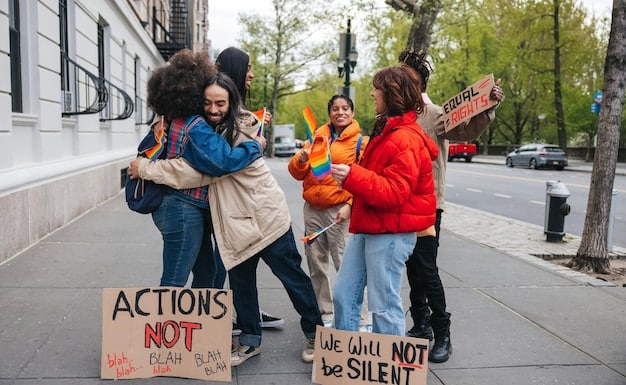Gun Violence on Gen Z: Can Control Reduce School Shootings by 30%?

The impact of gun violence on Gen Z is profound, and the feasibility of reducing school shootings by 30% within two years through increased gun control measures is a complex issue requiring comprehensive analysis of legislative effectiveness, mental health interventions, and societal factors.
The specter of gun violence looms large over American society, casting a particularly long shadow on Generation Z. From active shooter drills in kindergarten to witnessing tragic headlines during their formative years, this generation has grown up in an era defined by a chilling prevalence of firearms. The question, “The Impact of Gun Violence on Gen Z: Can Increased Gun Control Measures Reduce School Shootings by 30% in the Next 2 Years?” is not merely academic; it’s a desperate plea for safety and a call for tangible solutions.
Understanding Gen Z’s Unique Exposure to Gun Violence
Generation Z, broadly defined as those born between the mid-1990s and early 2010s, has never known a world free from the threat of mass shootings, especially within educational institutions. This constant exposure has profoundly shaped their worldview, their mental health, and their expectations of safety in public spaces. Unlike previous generations, active shooter drills are a routine, albeit traumatizing, part of their education, rather than an unthinkable anomaly.
This generation has been forced to internalize a level of existential threat that is unprecedented. The emotional and psychological toll is immense, manifesting in various forms, from heightened anxiety and depression to a pervasive sense of distrust in societal institutions designed to protect them. Their sense of normalcy has been irrevocably altered, creating a generation acutely aware of their vulnerability.
The Psychological Scarring of School Shootings
The psychological impact extends far beyond those directly involved in a shooting. News coverage, social media saturation, and the constant threat of “what if” scenarios create a ripple effect across the entire generation. Many Gen Z individuals report living with chronic stress and fear, impacting their daily lives, academic performance, and social interactions.
- Chronic anxiety and panic attacks related to public spaces.
- Increased rates of depression and post-traumatic stress symptoms.
- Difficulty concentrating in school due to safety concerns.
- Distrust in adults and authority figures to ensure their protection.
Moreover, for many, the collective trauma has galvanized them into activism, demanding changes they believe will safeguard their future. This generation is not passively accepting their fate; they are actively seeking solutions and advocating for policy changes, making their voices heard on a critical issue that directly affects their well-being.
The Digital Age and Amplified Trauma
The pervasive nature of social media further amplifies the trauma. News spreads instantly, often with graphic details, making it almost impossible for Gen Z to escape the grim realities of gun violence. This constant exposure can lead to vicarious trauma and a feeling of helplessness, as they witness events unfold in real-time or through endless replays. The digital age, while connecting them, also acts as a relentless conveyor of fear and despair when it comes to such incidents.
The inability to completely disconnect from these narratives means that the healing process is often interrupted or prolonged. The mental health support systems available often struggle to keep pace with the scale of this unique, digitally amplified trauma. Addressing the impact on Gen Z requires a multi-faceted approach that acknowledges both the physical and digital landscapes they inhabit.
Examining the Landscape of Gun Control Measures in the US
The debate surrounding gun control in the United States is deeply entrenched and highly politicized, with passionate arguments on both sides. Understanding the current legislative framework and the proposed changes is crucial to assessing their potential efficacy in reducing school shootings. There’s a wide spectrum of measures, each with its own set of supporters and detractors.
Current federal gun laws include background checks for firearms purchased from licensed dealers, restrictions on certain types of firearms (though often challenged), and prohibitions for individuals with specific criminal histories or mental health adjudications. However, state laws vary significantly, creating a patchwork system that critics argue is ineffective in preventing the interstate flow of weapons used in crimes.
Proposed Gun Control Interventions
When policymakers discuss increased gun control measures, a range of interventions are typically on the table. These proposals aim to reduce the availability of firearms to individuals deemed high-risk, or to limit the capacity for mass casualties in shooting incidents. Each has different implications for the rights of gun owners and the overall safety landscape.
- Universal Background Checks: Expanding federal background checks to all firearm sales, including private transactions, is a common proposal. Proponents argue this would close loopholes that allow individuals prohibited from owning guns to acquire them.
- Assault Weapons Bans: Reinstating or strengthening bans on certain semi-automatic rifles, often referred to as “assault weapons,” and high-capacity magazines. The argument is that these weapons are designed for rapid, mass casualties and are frequently used in school shootings.
- Red Flag Laws (Extreme Risk Protection Orders): Allowing temporary removal of firearms from individuals deemed a danger to themselves or others by a court order. This aims to intervene before violence occurs, based on credible threats or concerning behavior.
- Safe Storage Laws: Requiring firearms to be stored securely, reducing accidental shootings and preventing access by unauthorized individuals, particularly minors or those with dangerous intent.
The effectiveness of these measures is a subject of intense debate, often relying on complex statistical analysis and conflicting interpretations of data. Understanding the nuances of each proposal is essential for a productive conversation about their potential impact on public safety, especially in schools.
Challenges in Implementation and Enforcement
Even with new legislation, the path to implementation and effective enforcement is fraught with challenges. Legal battles, resource allocation, and varying levels of political will across different states can significantly impact the real-world effect of gun control measures. For example, federal laws require consistent enforcement across all states for maximum impact.

Furthermore, the judicial system plays a crucial role. Courts often interpret the Second Amendment in ways that can either uphold or strike down gun control legislation, adding another layer of complexity. This legal landscape means that even well-intentioned laws can face significant hurdles before they can be fully implemented and their impact assessed.
The 30% Reduction Target: A Realistic Expectation?
The ambitious target of reducing school shootings by 30% within two years is a bold statement, reflecting the urgency of the crisis. To gauge its realism, one must look at existing data, academic studies on gun control effectiveness, and the historical trajectory of such incidents. No easy answer exists, as outcomes depend on a multitude of variables.
Historical data on gun violence and school shootings is complex and often subject to different interpretations. While some studies suggest a correlation between specific gun control measures and reduced gun violence rates, the direct causal link, especially within short timeframes, is harder to establish definitively. The unique nature of school shootings, often involving complex motivations and individual circumstances, adds another layer of difficulty.
Evidence from Past Gun Control Initiatives
Studies examining the impact of various gun control laws offer mixed results, often depending on the specific measure and the context. For instance, some research indicates that universal background checks are associated with fewer firearm homicides, while others point to the challenges in accurately measuring the impact of bans on specific weapon types. The effectiveness isn’t always immediate or uniform.
- States with stricter gun laws generally have lower rates of gun violence.
- The 1994 federal assault weapons ban has been debated regarding its impact, with some studies showing a reduction in mass shooting fatalities during its tenure.
- Red flag laws, when properly implemented, have been credited with potentially preventing suicides and other forms of gun violence.
However, it is also important to consider the counterarguments and limitations of these studies. Factors such as socio-economic conditions, mental health support, and broader cultural attitudes towards firearms can also influence gun violence statistics, making it difficult to isolate the impact of legislation alone.
Beyond Legislation: A Broader Approach
Achieving a 30% reduction may require more than just legislative changes. A holistic approach that includes robust mental health support for students, intelligence gathering to identify potential threats, and enhanced physical security measures in schools might be necessary. Legislation typically addresses the “how,” but the “why” often lies in deeper societal issues.
School resource officers, anonymous reporting systems, and positive school climates that foster connection and support can also play a role in prevention. The goal should be to create multiple layers of defense, making schools less vulnerable targets and addressing the root causes of violence, whether they are mental health crises or violent ideologies.
The Role of Mental Health and Threat Assessment
While gun control focuses on regulating access to firearms, a critical component of preventing school shootings lies in addressing the underlying issues that drive individuals to commit such acts. Mental health struggles, feelings of isolation, and a history of trauma are frequently identified as contributing factors in profiles of school shooters. Thus, a comprehensive strategy must integrate robust mental health support and effective threat assessment programs.
Many perpetrators of school violence have exhibited warning signs prior to their actions, though these signs are often missed or misinterpreted. Developing systems that can identify individuals at risk and provide them with timely intervention is paramount. This requires a shift from solely reactive measures to proactive prevention strategies that address the human element of the crisis.
Early Intervention and Support Systems
Investing in mental health resources for young people is not just about crisis management; it’s about fostering resilience and well-being from an early age. Schools are often the first line of defense, and adequately staffed counseling services, social workers, and psychologists can make a significant difference. Regular screenings and accessible support can help identify issues before they escalate.
- Increased funding for school-based mental health professionals.
- Implementation of social-emotional learning programs in curricula.
- Reduced stigma surrounding mental health issues, encouraging students to seek help.
- Accessible community mental health services for youth and families.
These initiatives aim to create a supportive environment where students feel comfortable expressing their struggles and seeking help. A culture of care and early intervention can deter potential crises, offering alternatives to violence and despair by addressing the root causes of distress.
Developing Effective Threat Assessment Programs
Threat assessment teams, multidisciplinary groups typically found within schools, are designed to identify, assess, and manage students who may pose a threat of violence. These teams look at behaviors and communications, rather than profiling, to determine risk and implement appropriate interventions. Their effectiveness relies on clear protocols, trained personnel, and cooperation from the school community.
The key to successful threat assessment is to distinguish between individuals who express concerning thoughts versus those who are genuinely planning harm. It involves a process of gathering information from multiple sources, evaluating the intent and capability of the individual, and developing a plan to mitigate any identified risks. This often involves collaboration with law enforcement, mental health professionals, and parents.
Technological Solutions and School Security Enhancements
Beyond legislation and mental health initiatives, technology and physical security measures offer another layer of defense against school shootings. While not a standalone solution, integrating these enhancements can create a more secure environment, potentially deterring attacks or mitigating their impact. This includes everything from advanced surveillance to access control systems.
The landscape of school security is constantly evolving, driven by innovations in technology and a greater understanding of vulnerabilities. Schools are increasingly adopting a multi-layered security approach, combining physical barriers with sophisticated monitoring systems to enhance protection for students and staff. The goal is to make schools less attractive targets.
Innovations in School Building Security
Modern school designs and retrofits are incorporating features specifically aimed at enhancing safety. These range from basic physical deterrents to cutting-edge technological solutions that can alert authorities and provide real-time information during an event. The strategic deployment of these technologies can buy critical time in an active shooter situation.
- Controlled access points, including reinforced doors and single-entry systems.
- Advanced surveillance systems with artificial intelligence capabilities for anomaly detection.
- Ballistic-resistant windows and doors in key areas.
- Emergency communication systems that integrate with law enforcement for rapid response.
These security enhancements are often costly, requiring significant investment from school districts and government funding. However, proponents argue that the cost is justified by the potential to save lives and provide a safer learning environment, contributing to the overall well-being of the school community. Balancing security with a welcoming atmosphere remains a challenge.
The Promise and Peril of AI in Security
Artificial intelligence is increasingly being explored for its potential role in school safety. AI-powered analytics can process large amounts of data from surveillance cameras, social media, and other sources to identify potential threats or unusual behaviors. For example, AI could detect a weapon being carried onto school grounds or flag concerning online posts by students.

However, the use of AI in security raises significant ethical and privacy concerns. Questions about data collection, potential biases in algorithms, and the risk of false positives need to be carefully addressed. The goal is to leverage technology for safety without infringing on civil liberties or creating a dystopian surveillance state within schools. Striking this balance is crucial for public acceptance and effective deployment.
Gen Z’s Advocacy and Its Influence on Policy
Unlike previous generations who might have experienced similar traumas but lacked the digital platforms for immediate global mobilization, Generation Z has leveraged social media and modern activism to amplify their voices. Their direct experience with gun violence, particularly school shootings, has transformed many into passionate and articulate advocates for change. This activism has become a significant force shaping policy debates.
From organizing nationwide marches to engaging with lawmakers on local and federal levels, Gen Z is actively participating in the political process, demanding accountability and tangible solutions. Their personal narratives and lived experiences provide a powerful counterpoint to abstract policy discussions, making the issue profoundly personal and urgent for many.
Youth-Led Movements and Their Impact
The aftermath of events like the Parkland shooting saw the emergence of powerful youth-led movements, such as March For Our Lives. These organizations quickly mobilized millions, attracting global attention and significantly influencing political discourse. Their ability to connect with peers and use digital tools for grassroots organizing has been unparalleled.
- Organizing large-scale protests and rallies across the nation.
- Registering young voters and encouraging political participation.
- Engaging in direct lobbying efforts with elected officials.
- Utilizing social media platforms to educate and persuade the public.
These movements have demonstrated a pragmatic approach, advocating for specific policy changes while also fostering a broader cultural conversation about gun violence. Their sustained efforts have pushed the issue higher on the political agenda, forcing candidates and incumbent politicians to address their concerns directly.
Shifting Public Opinion and Electoral Pressure
The relentless advocacy of Gen Z has contributed to a noticeable shift in public opinion regarding gun control. Polls increasingly show strong support, even among conservative demographics, for certain gun safety measures. This generational shift in attitudes is creating electoral pressure, particularly as younger voters become a more significant demographic in elections.
Politicians are increasingly recognizing that ignoring the demands of this engaged generation comes with political risks. As Gen Z reaches voting age en masse, their unified stance on gun violence could prove to be a deciding factor in future elections, pushing lawmakers towards concrete actions rather than rhetorical gestures. Their influence is not just about changing minds; it’s about changing who holds power.
The Road Ahead: Challenges and Opportunities for Change
The journey to significantly reduce school shootings and mitigate the impact of gun violence on Generation Z is fraught with challenges, yet it also presents distinct opportunities for profound societal change. The complex interplay of legislative hurdles, cultural divides, and resource allocation means there is no single, simple solution. However, the collective will for safer communities remains a powerful catalyst.
Overcoming political polarization is perhaps the largest challenge. The issue of gun control often becomes a battleground for broader ideological conflicts, making consensus difficult. Yet, the persistent advocacy of Gen Z, coupled with ongoing research and innovative approaches, offers a glimmer of hope that common ground can be found, especially on measures designed to protect children.
Bridging the Divide: Seeking Common Ground
Finding solutions that garner bipartisan support is essential for sustainable change. This often involves focusing on measures that enjoy broad public backing, such as improved background checks or red flag laws, rather than those that are highly contentious. Emphasizing public safety over political posturing could unlock pathways to progress.
- Prioritizing evidence-based policies over ideological stances.
- Investing in community violence intervention programs.
- Enhancing data collection and research on gun violence to inform policy.
- Promoting dialogue between gun owners and gun control advocates to find common solutions.
Efforts to bridge the divide also involve addressing the underlying factors contributing to violence, such as poverty, lack of opportunity, and systemic inequities. A holistic approach acknowledges that gun violence is a symptom of deeper societal issues, requiring equally deep and comprehensive solutions that extend beyond just firearms.
The Long-Term Vision for Gen Z’s Safety
Ultimately, the goal is to create a future where Generation Z, and generations to come, can attend school without fear, grow up free from the trauma of gun violence, and feel secure in their communities. This long-term vision requires sustained commitment, adaptability, and a willingness to evolve strategies as new challenges emerge. The 30% reduction target is an immediate milestone, but the ultimate aim is an end to this crisis.
The collective efforts of policymakers, educators, mental health professionals, community leaders, and the passionate youth themselves will determine whether this generation can finally reclaim its right to safety. It’s a generational imperative, driven by the unwavering demands of those who have borne the brunt of this ongoing tragedy. The road is long, but the motivation for change is stronger than ever.
| Key Point | Brief Description |
|---|---|
| 😨 Gen Z Trauma | This generation faces unique psychological burdens from constant gun violence exposure, notably in schools. |
| ⚖️ Gun Control Measures | Proposals like universal background checks and red flag laws aim to restrict firearm access to high-risk individuals. |
| 🧠 Mental Health Focus | Integrating robust mental health support and effective threat assessment is crucial for prevention. |
| 🗣️ Gen Z Activism | Youth-led movements significantly influence policy debates and public opinion on gun violence. |
Frequently Asked Questions About Gun Violence & Gen Z
Gen Z experiences heightened anxiety, chronic stress, and increased rates of depression due to constant exposure to gun violence, particularly school shootings. Active shooter drills and pervasive media coverage contribute to a pervasive sense of fear and insecurity, profoundly impacting their emotional well-being and sense of safety in public spaces. This impacts their overall development.
Increased gun control measures typically refer to a range of legislative proposals aimed at reducing gun violence. These often include universal background checks for all firearm sales, bans on certain types of semi-automatic weapons and high-capacity magazines, and the implementation of “red flag” laws, which temporarily remove firearms from individuals deemed a threat.
Achieving a 30% reduction in school shootings within two years is an ambitious goal. Its realism depends on the specific measures implemented, their scope, enforcement, and the concurrent investment in mental health support and threat assessment programs. While some studies show correlations between stricter gun laws and reduced gun violence, rapid, significant changes are challenging to predict and achieve.
Mental health intervention is critically important. Many perpetrators of school violence exhibit warning signs related to mental health struggles, isolation, or trauma. Robust school-based mental health services, early intervention programs, and effective threat assessment teams are essential for identifying at-risk individuals and providing help before violent acts occur, complementing gun control efforts.
Gen Z plays a pivotal role in advocating for changes. Leveraging social media, they organized powerful youth-led movements like March For Our Lives. Their personal experiences with gun violence fuel their activism, driving voter registration, lobbying efforts, and public awareness campaigns. This generation effectively translates their trauma into political pressure, influencing policy debates and electoral outcomes.
Conclusion
The impact of gun violence on Generation Z is an undeniable and pressing crisis, deeply scarring a generation that has known little else but fear in their formative years. The ambitious question of whether increased gun control measures can reduce school shootings by 30% in two years underscores a nationwide urgency for effective solutions. While a definitive answer remains complex, it’s clear that a multifaceted approach—combining legislative reforms, robust mental health interventions, technological advancements in security, and the unwavering advocacy of Gen Z—offers the most viable path forward. The path to safety for future generations requires sustained commitment, collaborative effort, and a profound shift in societal priorities to protect our most vulnerable.





